
Wine Culture and Information since 2002 - Volume 22
 Wine Culture and Information since 2002 - Volume 22 |
|
Mature Red WinesAccording to wine lovers, reds are the wines par excellence to be aged in cellar for a long time. The possibilities of aging over time are in effect very good, however this is not true for every red |
|
The more a red wine ages, the better. This is what most of wine lovers believe, as well as most of consumers. The fact a red wine can age, and for certain aspects, improve with time, there is no doubt about this. The other truth is that not all the red wines can improve with time, indeed, a long time can be completely lethal for most of them. A matter of time, therefore. How much time? How long can this magic time be in order to give a red wine its highest expression, therefore making it a refined and paradisiacal nectar? The answer is not so easy and, maybe, the most logic answer one can give is “it depends”. There are many factors influencing the effects of time and the possibilities of aging in a red wine, something however true for any type of wine, with no exception. In case we try to think in absolutely relative terms, we can say red wines are among the most longevous ones. Despite red wines are usually suited to be aged for a long time, this rule is not true for every red wine. Let's try, first of all, to define, in case this is possible, a limit of time allowing us to understand the aging potential of red wines. If it is true that for many wine styles the duration of aging generally is well definable, in reds this definition is pretty hard, as - contrary to other styles - in this case the duration is affected by many factors. Red wines, according to the factors we will discuss later, can in fact age for a period of time ranging from few years to many decades. Moreover, there are cases - to be however considered as exceptions - in which certain red wines, with a solid reputation to long period of aging, can develop for more than one hundred years. Among the elements naturally found in red wines and significantly contributing to their longevity there are the so called tannins, properly defined “polyphenols”. The quantity of tannins in red wines generally depends on the wine making practices, and in particular, to the specific variety of grape. Last but not the least, we should notice the so called tannins can also be added to the wine during its production, a technique permitted by law, sometimes also used for white wines. Every variety has a natural quantity of tannins and variable according to the type of grape. Therefore, there are red berried grapes naturally having a rich quantity of tannins, whereas others contain a modest quantity of tannins. The place in which tannins are found in grapes is the skin, however it should be noticed these substances are also found in pips and, despite this part is rarely used in wine making, they are also found in stalks. For example, varieties such as Nebbiolo and Sagrantino, have skins very rich in tannins, whereas the skin of Pinot Noir has a far lower quantity. As a “general” rule, grapes naturally rich in tannins make wines suited for the long aging, whereas the ones poor in tannins give wines to be consumed within few years. This general rule however needs to be better understood. If it is true varieties naturally rich in polyphenols are more suited to the production of wines destined to the long aging, this is however variable according to the method with which a grape is being cultivated and therefore vinified. To simplify this concept, grapes cultivated in order to have an abundant yield, give grapes with very low concentration of tannins - as well as all the other substances in berries - as opposed to vineyards cultivated in order to get a low yield, giving grapes with higher concentration of substances.
Wines produced with grapes cultivated in vineyards of high yields, even in case of varieties having a good name and of proven quality, will not give wines capable of challenging time with the same strength of those produced with grapes from vineyards of low or very low yield. Therefore, as a practical example, which must however be considered in general terms, a Nebbiolo d'Alba produced with grapes from vineyards of high yield, after just five years can show evident signs of decay. The same Nebbiolo d'Alba, produced with grapes from vineyards of low yield, vinified with high quality principles, can magnificently age for more than 30 years, just like the most renowned Barolo or Barbaresco. To the tannins naturally contained in grape's berry, are also added the ones released by the cask during the fermentation and aging processes, tannins which will contribute to give the wine a better chance of aging over time. Of course, not all the casks are the same. The quantity and quality of tannins added to the wine during the fermentation and aging, depend on many factors, of which the most important ones are time and volume. In fact, the smaller the cask - such as the famous barrique - the higher the volume to surface contact ratio, in other words, given the same period of time, the release of tannins is higher, with a greater impact on wine's organoleptic qualities. In large casks, still used today and in particular very appreciated among the so called “traditionalist” producers, the volume to surface contact ratio is lower, as well as the impact of wine's organoleptic qualities. By considering what has been just said, one can think a wine aged in barrique - thanks to the greater release of tannins - can therefore age in bottle for a longer time, thus obtaining a more longevous wine than the ones aged in a large cask. Indeed, it is not like that. There are many other factors to be considered in technical characteristics of a cask, not only its volume, but also the type of wood used for its making, the aging of wood, thickness of staves and the number of passages done in the cask, in other words, the number of times a cask has been used. The wood of a new cask has a higher quantity of tannins than a cask used for three years in a row, in which part of tannins has been lost during past uses. In order to avoid misunderstandings, it should be noticed - indeed, emphasized - the primary use of a cask in wine making is not associated to the release of tannins to the wine, therefore significantly influencing its organoleptic profile. The role of a cask is to allow the aging of wine, by allowing it to take the youth clothes off and to dress it with a more elegant and mature tuxedo. This “miracle” is made, in particular, by the infinitesimal - but continuous - passage of oxygen, that from the outside of the cask, by passing through the pores of wood, gets to the inside. This very precious process, as a matter of facts, favors a providential and indispensable oxidation done in a very long time. Although oxygen is among the main enemies to the longevity of a wine, a small and slow oxidation gives a better stability, therefore a better longevity. Longevity in red wines is not however associated to the quantity of polyphenols only. There are also other factors significantly contributing to its longevity. In sweet red wines, a style of wine existing in few examples only - of which, Sagrantino di Montefalco Passito, Recioto della Valpolicella and Aleatico dell'Elba - sugar ensures a better possibility of keeping, a factor supporting all the other ones. Two factors significantly contributing to the aging of a red wine, or - better to say - to its keeping, are represented by alcohol and acidity. Whereas alcohol is always found in pretty high quantity - today the common trend, even for giving a better balance, is to make wines with an average alcohol by volume of 13.5% - whereas acidity in red wines is an extremely variable factor. It is well known acidity in red wines is lower than white wines, however it is not completely absent. The quantity of acid substances in red wines, although this can also be added during the making process - a practice permitted by law - it is strongly associated to the variety of grape. In the vast number of red berried grapes, the quantity of acid substances contained in berries is in fact quite variable, even though - it should be said - in general terms, it is never expressed by a high value, with just few exceptions. These varieties with an evident acid mark are very appreciated by a large number of wine lovers, as they believe these grapes can give wines of remarkable elegance, in particular Pinot Noir. When it is found in appreciable quantity, acidity significantly contributes to the longevity of a red wine, and therefore to its capacity of aging, therefore strengthening the possibility offered by polyphenols and alcohol. For example, we can think about Nebbiolo - the great and typical red berried grape of Langhe and Piedmont - a variety rich both in polyphenolic substances as well as acid substances, to which is added the good quantity of sugar, with the result of making a remarkable quantity of alcohol. It is not by chance wines produced with Nebbiolo grape can magnificently age for tens of years, while developing a quality of impeccable elegance and finesse. Also other grapes characterized by a basically acid profile - such as Pinot Noir and Sangiovese - despite they do not contain high quantity of polyphenols, thanks to the aging in cask, a procedure enriching the wine of tannins, can age for tens of years in bottle. For example, we can think about the great red wines from Burgundy, Brunello di Montalcino and Vino Nobile di Montepulciano. Time gives red wine a new sensorial dimension, in which it is hardly possible to recognize the impetuous quality expressed in youth. The most evident transformation is about the so called tannins, an effect which can be perceived both to the eye and to the taste. With time, and thanks to the micro oxygenation obtained by the passage of oxygen through the cork, tannin molecules tend to polymerize, a process making them less soluble to the saliva and, as their weight increases, they tend to precipitate to the bottom. The most evident effect on the appearance, wines lose the typical intense color of youth and their evident purple and ruby colors get a hue of garnet red and, with time, brick red. To the taste, as they become less soluble to the saliva, the typical astringent effect of tannins will be evidently mitigated: the wine will get a rounder and softer character, while keeping its appreciable structure. Also in this case, as an example, we can think about Barolo or reds from Bordeaux allowed to age for a long time in bottle. Also the aromatic profile of red wines aged for a long time, changes and develops significantly, most of the times completely changing its character. Aromas get enriched with qualities defined as tertiary, quality which are mainly developed thanks to the effect of oxygen that, in order to be effective, it must enter the bottle - as well as the cask - in very small quantity and for a very long period of time. The long permanence in bottle, can frequently cause the phenomenon of reduction, that, in practice, is the opposite effect to oxidation and which takes place in case a wine stays for a long time in total absence of oxygen. If oxygenation exalts the development and evolution of aromas, reduction contributes to the flattening of this development, making the wine “dull” as if it does not want to express any aromatic quality, while replacing them with the characteristic reduction smell. The cure for reduction is however simple: it is enough to expose the wine to the oxygen in order to bring it back to life. The most simple method is to pour the wine in a large glass and to swirl it for few minutes in order to favor the oxygenation and the expression of its aromas.
|
||||||||||||
Wines of the Month |
|
|
|
Score legend Prices are to be considered as indicative. Prices may vary according to the country or the shop where wines are bought |
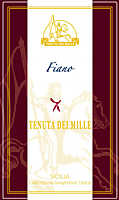
|
|
Fiano 2009 |
|
| Tenuta dei Mille (Sicily, Italy) | |
| Grapes: Fiano | |
| Price: € 6.00 | Score: |
| This Fiano shows a brilliant golden yellow color and nuances of golden yellow, very transparent. The nose denotes intense, clean and pleasing aromas which start with hints of apple, plum and hawthorn followed by aromas of almond, citrus fruits and honey. The mouth has good correspondence to the nose, a crisp attack and however balanced by alcohol, good body, intense flavors, pleasing roundness. The finish is persistent with flavors of apple, plum and almond. | |
| Food Match: Pasta and risotto with fish, Sauteed fish, Vegetable soups | |
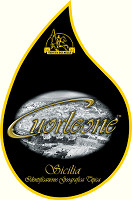
|
|
Cuorleone 2008 |
|
| Tenuta dei Mille (Sicily, Italy) | |
| Grapes: Nero d'Avola, Syrah | |
| Price: € 7.00 | Score: |
| Cuorleone shows a brilliant ruby red color and nuances of garnet red, moderate transparency. The nose reveals intense, clean, pleasing and refined aromas which start with hints of plum, black cherry and black currant followed by aromas of blackberry, vanilla, tobacco and chocolate. The mouth has good correspondence to the nose, a tannic attack and however balanced by alcohol, good body, intense flavors, pleasing roundness. The finish is persistent with flavors of plum, black cherry and black currant. | |
| Food Match: Broiled meat and barbecue, Stewed meat with mushrooms, Roasted meat | |
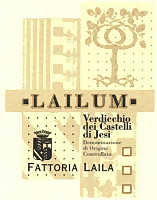
|
|
Verdicchio dei Castelli di Jesi Classico Riserva Lailum 2009 |
|
| Fattoria Laila (Marches, Italy) | |
| Grapes: Verdicchio | |
| Price: € 10.00 | Score: |
| Verdicchio dei Castelli di Jesi Classico Riserva Lailum shows a pale straw yellow color and nuances of greenish yellow, very transparent. The nose denotes intense, clean, pleasing and refined aromas that start with hints of apple, pear and plum followed by aromas of hawthorn, anise, broom and almond. The mouth has good correspondence to the nose, a crisp attack and however balanced by alcohol, good body, intense flavors, pleasing roundness. The finish is persistent with flavors of apple, pear and plum. Verdicchio dei Castelli di Jesi Classico Riserva Lailum ferments in cask and a part ages in barrique. | |
| Food Match: Fish and crustacean appetizers, Risotto with fish and crustaceans | |
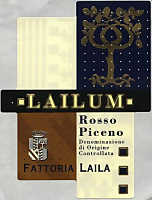
|
|
Rosso Piceno Lailum 2008 |
|
| Fattoria Laila (Marches, Italy) | |
| Grapes: Montepulciano (85%), Sangiovese (15%) | |
| Price: € 13.00 | Score: |
| Rosso Piceno Lailum shows an intense ruby red color and nuances of garnet red, little transparency. The nose denotes intense, clean, pleasing and refined aromas that start with hints of black cherry, plum and violet followed by aromas of blueberry, blackberry, vanilla, tobacco, cocoa, cinnamon and menthol. The mouth has good correspondence to the nose, a tannic attack and however balanced by alcohol, good body, intense flavors, pleasing roundness. The finish is persistent with flavors of black cherry, plum and blackberry. Rosso Piceno Lailum ages for at least 16 months in barrique. | |
| Food Match: Roasted meat, Broiled meat and barbecue, Stewed and braised meat with mushrooms, Hard cheese | |
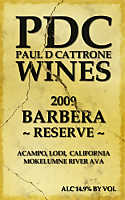
|
|
Barbera Reserve 2009 |
|
| Paul D Cattrone Wines (California, USA) | |
| Grapes: Barbera | |
| Price: $ 15.60 | Score: |
| Barbera Reserve shows a brilliant ruby red color and nuances of garnet red, moderate transparency. The nose reveals intense, clean, pleasing and refined aromas that start with hints of cherry, raspberry and blueberry followed by aromas of violet, vanilla, tobacco, cocoa and menthol. The mouth has good correspondence to the nose, a slightly tannic attack and however balanced by alcohol, good body, intense flavors, pleasing roundness. The finish is persistent with flavors of cherry, blueberry and raspberry. Barbera Reserve ages for 15 months in cask followed by 4 months of aging in bottle. | |
| Food Match: Broiled meat and barbecue, Stewed meat with mushrooms, Hard cheese | |

|
|
Carignano del Sulcis Cenere 2008 |
|
| Mulleri (Sardinia, Italy) | |
| Grapes: Carignano | |
| Price: € 12.50 | Score: |
| Carignano del Sulcis Cenere shows a brilliant ruby red color and nuances of garnet red, moderate transparency. The nose denotes intense, clean and pleasing aromas which start with hints of black cherry, plum and blueberry followed by aromas of violet, vanilla, tobacco and menthol. The mouth has good correspondence to the nose, a tannic attack and however balanced by alcohol, good body, intense flavors. The finish is persistent with flavors of black cherry, plum and blueberry. Carignano del Sulcis Cenere ages for 3 months in barrique followed by 3 months of aging in bottle. | |
| Food Match: Sauteed meat, Stewed meat with mushrooms, Hard cheese | |

|
|
Vermentino di Sardegna Soffio 2010 |
|
| Mulleri (Sardinia, Italy) | |
| Grapes: Vermentino | |
| Price: € 12.50 | Score: |
| Vermentino di Sardegna Soffio shows a pale greenish yellow color and nuances of greenish yellow, very transparent. The nose denotes intense, clean and pleasing aromas that start with hints of peach, pear and apple followed by aromas of pineapple, broom and plum. The mouth has good correspondence to the nose, a crisp attack and however balanced by alcohol, good body, intense flavors, agreeable. The finish is persistent with flavors of peach, apple and pear. Vermentino di Sardegna Soffio ages in steel tanks. | |
| Food Match: Fish and crustaceans appetizers, Risotto with crustaceans | |
|
|
|
Solemio 2010 |
|
| Icone (Sicily, Italy) | |
| Grapes: Grillo | |
| Price: € 6.92 | Score: |
| Solemio shows a brilliant straw yellow color and nuances of straw yellow, very transparent. The nose reveals intense, clean, pleasing and refined aromas which start with hints of apple, peach and almond followed by aromas of citrus fruits, pineapple, hawthorn and broom. The mouth has good correspondence to the nose, a crisp attack and however balanced by alcohol, good body, intense flavors, pleasing roundness. The finish is persistent with flavors of apple, peach and almond. Solemio ages in steel tanks. | |
| Food Match: Pasta and risotto with fish, Sauteed fish, Vegetable soups | |
|
|
|
Sense 2006 |
|
| Icone (Sicily, Italy) | |
| Grapes: Nero d'Avola | |
| Price: € 15.84 | Score: |
| Sense shows a brilliant ruby red color and nuances of garnet red, moderate transparency. The nose denotes intense, clean, pleasing and refined aromas which start with hints of plum, blackberry and black cherry followed by aromas of dried violet, blueberry, cinnamon and carob. The mouth has good correspondence to the nose, a slightly tannic attack and however balanced by alcohol, good body, intense flavors, agreeable. The finish is persistent with flavors of plum, blackberry and black cherry. Sense ages in cement tanks. | |
| Food Match: Broiled meat and barbecue, Stewed meat, Hard cheese | |
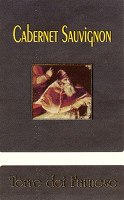
|
|
Colli Piacentini Cabernet Sauvignon Terre dei Farnese 2006 |
|
| Testa (Emilia Romagna, Italy) | |
| Grapes: Cabernet Sauvignon | |
| Price: € 12.00 | Score: |
| Colli Piacentini Cabernet Sauvignon Terre dei Farnese shows an intense ruby red color and nuances of garnet red, moderate transparency. The nose denotes intense, clean, pleasing and refined aromas which start with hints of black cherry, black currant and plum followed by aromas of blueberry, dried violet, tobacco, vanilla, chocolate and eucalyptus. The mouth has good correspondence to the nose, a tannic attack and however balanced by alcohol, good body, intense flavors, pleasing roundness. The finish is persistent with flavors of black cherry, black currant and plum. Colli Piacentini Cabernet Sauvignon Terre dei Farnese ages for 12 months in cask. | |
| Food Match: Roasted meat, Stewed meat, Broiled meat and barbecue, Hard cheese | |
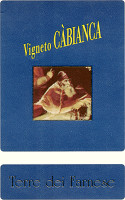
|
|
Colli Piacentini Gutturnio CàBianca Terre dei Farnese 2004 |
|
| Testa (Emilia Romagna, Italy) | |
| Grapes: Barbera (70%), Croatina (30%) | |
| Price: € 12.00 | Score: |
| Colli Piacentini Gutturnio CàBianca Terre dei Farnese shows a deep ruby red color and nuances of garnet red, little transparency. The nose reveals intense, clean, pleasing and refined aromas which start with hints of plum, black cherry and blackberry followed by aromas of dried violet, vanilla, cocoa, tobacco, clover and menthol. The mouth has good correspondence to the nose, a slightly tannic attack and however balanced by alcohol, good body, intense flavors, pleasing roundness. The finish is persistent with flavors of plum, black cherry and blackberry. Colli Piacentini Gutturnio CàBianca Terre dei Farnese ages in cask for 12 months. | |
| Food Match: Broiled meat and barbecue, Roasted meat, Stewed meat, Hard cheese | |
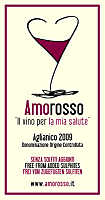
|
|
Aglianico del Vulture 2009 |
|
| Amorosso (Basilicata, Italy) | |
| Grapes: Aglianico | |
| Price: € 21.00 | Score: |
| This Aglianico del Vulture shows an intense ruby red color and nuances of ruby red, little transparency. The nose reveals intense, clean, pleasing and pleasing aromas which start with hints of plum, blackberry and black cherry followed by aromas of dried violet, blueberry, carob and pink pepper. The mouth has good correspondence to the nose, a tannic attack and however balanced by alcohol, good body, intense flavors, pleasing roundness. The finish is persistent with flavors of plum, blackberry and black cherry. This Aglianico del Vulture ages in steel tanks. | |
| Food Match: Stuffed pasta, Broiled meat and barbecue, Stewed meat with mushrooms | |
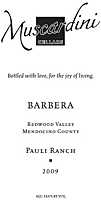
|
|
Barbera 2009 |
|
| Muscardini Cellars (California, USA) | |
| Grapes: Barbera | |
| Price: $ 38.00 | Score: |
| This Barbera shows a brilliant ruby red color and nuances of ruby red, moderate transparency. The nose reveals intense, clean, pleasing and refined aromas which start with hints of cherry, blueberry and raspberry followed by aromas of violet, plum, vanilla, tobacco, chocolate and mace. The mouth has good correspondence to the nose, a slightly tannic attack and pleasing crispness, however balanced by alcohol, good body, intense flavors, pleasing roundness. The finish is persistent with flavors of cherry, raspberry and blueberry. This Barbera ages for 12 months in barrique. | |
| Food Match: Stuffed pasta, Broiled meat and barbecue, Stewed meat with mushrooms | |
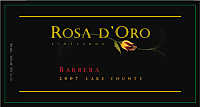
|
|
Barbera 2007 |
|
| Rosa d'Oro (California, USA) | |
| Grapes: Barbera | |
| Price: $ 18.00 | Score: |
| This Barbera shows an intense ruby red color and nuances of garnet red, moderate transparency. The nose denotes intense, clean, pleasing and refined aromas which start with hints of cherry, plum and violet followed by aromas of blueberry, vanilla, tobacco and chocolate. The mouth has good correspondence to the nose, a slightly tannic attack and however balanced by alcohol, good body, intense flavors, pleasing crispness. The finish is persistent with flavors of cherry, plum and blueberry. This Barbera ages for 14 months in barrique. | |
| Food Match: Broiled meat and barbecue, Stewed meat, Stuffed pasta | |
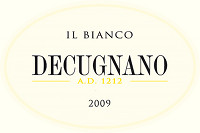
|
|
Orvieto Classico Superiore Il Bianco 2009 |
|
| Decugnano dei Barbi (Umbria, Italy) | |
| Grapes: Grechetto (50%), Vermentino (20%), Procanico (20%), Chardonnay (10%) | |
| Price: € 10.50 | Score: |
| Orvieto Classico Superiore Il Bianco shows a brilliant greenish yellow color and nuances of greenish yellow, very transparent. The nose reveals intense, clean, pleasing and refined aromas that start with hints of apple, plum and peach followed by aromas of hawthorn, broom, kiwi, almond, pear and mineral. The mouth has good correspondence to the nose, a crisp attack and however balanced by alcohol, good body, intense flavors, agreeable. The finish is persistent with flavors of apple, plum and peach. The Chardonnay ages in barrique. Orvieto Classico Superiore Il Bianco ages in steel tanks. | |
| Food Match: Pasta and risotto with fish and crustaceans, Fried fish, Sauteed fish | |
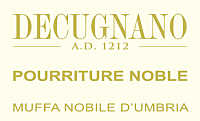
|
|
Pourriture Noble 2009 |
|
| Decugnano dei Barbi (Umbria, Italy) | |
| Grapes: Grechetto, Sauvignon Blanc | |
| Price: € 18.50 - 50cl | Score: |
| Pourriture Noble shows an intense straw yellow color and nuances of straw yellow, very transparent. The nose denotes intense, clean, pleasing, refined and elegant aromas which start with hints of quince, dried apricot and peach jam followed by aromas of chamomile, candied fruits, pineapple, pear, broom, acacia honey, almond and praline. The mouth has good correspondence to the nose, a crisp and pleasing sweet attack, however balanced by alcohol, good body, intense flavors, pleasing roundness. The finish is persistent with flavors of quince, dried apricot and candied fruits. Pourriture Noble ferments in steel tanks and ages for 6 months in bottle. | |
| Food Match: Dried fruit tarts, Confectionery | |
|
||||||||
|
DiWineTaste Polls
|
| |||||||
Privacy Policy | |||||||


| Copyright © 2002-2024 Antonello Biancalana, DiWineTaste - All rights reserved |
| All rights reserved under international copyright conventions. No part of this publication and of this WEB site may be
reproduced or utilized in any form or by any means, electronic or mechanical, without permission in writing from DiWineTaste. |